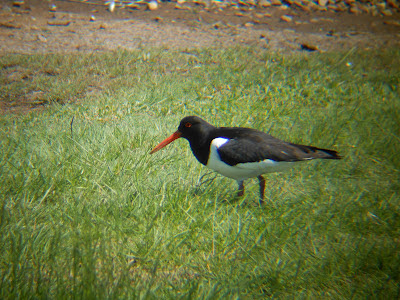4/06/12
Having completed our visit to our second site of the day, we then moved to another site nearby, one that i have never visited before, but one which often crops up with a few decent birds. I had 'scouted' the area on Google Maps (What an amazing tool) and was quite exited at the possibilites as 'The Gann' could produce, the habitat looked very good, and was only a small compact site, ideal for a quick visit!
The main reason for the visit to was to try and pick out some waders, however my hopes wernt exactly high as most waders would be back on breeding territory now.
Immidiatly upon arrival, a large flock of 48 Oystercather lazilly rested on the island within the pools. Infact, the largest flock of OYC ive seen!
There was a nice mix of plumages within the flock, ranging from 1st summers, non breeding adults, and breeding adults.
However, i was soon distracted by a multitude of Curlew calls as a flcok of 30 Waders took flight from rocks in the bay after being disturbed by walkers.
Closer and closer they flew, and i quickly latched onto 2 smaller waders within the flock. Still closer they flew, and as they neered, i was able to get a decent look at the smaller birds. Upturned bills, wedge up the back. RED!
BAR-TAILED GODWITS!
Awsome, immidiatly the stop in was worth it, and i enjoyed crippling in flight views of these waders, one which is fairly hard to get on a year to year basis with my lack of coastal birding, hoping from an inland straggler.
The birds moved closer, and i was able to get a couple of snaps of the flock as it flew around, over and over, trying to land on the pools, but comtinually being disturbed by further walkers.
A few WHIMBREL were also in the flock, one of which is highlighted in the photo below.
And here is a size comparison between a Curlew, and one of the Barwits (Presumably a female)
In total, 6 WHIMBREL were in the bay area of the Gann, flying to and fro between the Sea and the small river estury, calling frequently, which allerted us to their presence as they flew past.
It was only now however, that we noticed that the pebbly beach in front of us had a small gathering of small waders on it!
There certainly was more waders about than i was expecting!
A DUNLIN took close company with a pair of RINGED PLOVER (My first for the year!), which shown incredibally well on the shoreline. Infact, the closest views ive had without being in a hide!
The gathering preformed brilliantly, and allowed for some photos and videos.
I particuarly like the two above photos due to the 'mirroring' pose of the birds and the differential focus on the birds!
It was great just to be able to sit on the beach, watching these birds with the calling of Herring Gulls and the Sea lapping up the shore. Welcome to the seaside ladies and gents!
I tried to get a photo with a breaker wave coming in behind the bird, and this is all i managed!
The seaweed on the shore obviously held lots of food for them, as they spent much of their time picking from among it. Presumably feeding up on way to return to breeding territory.
The Summer plumaged DUNLIN kept very close company to the Ringed Plovers, and this too, allowed for some great views!
Again, i like this photo, and personally think its one of the best Dunlin photos ive taken!
And a bit of short video footage.
All in all, a very nice visit, and a great little spot to check out, another place to add to my list of places to go next year!
MB


















































